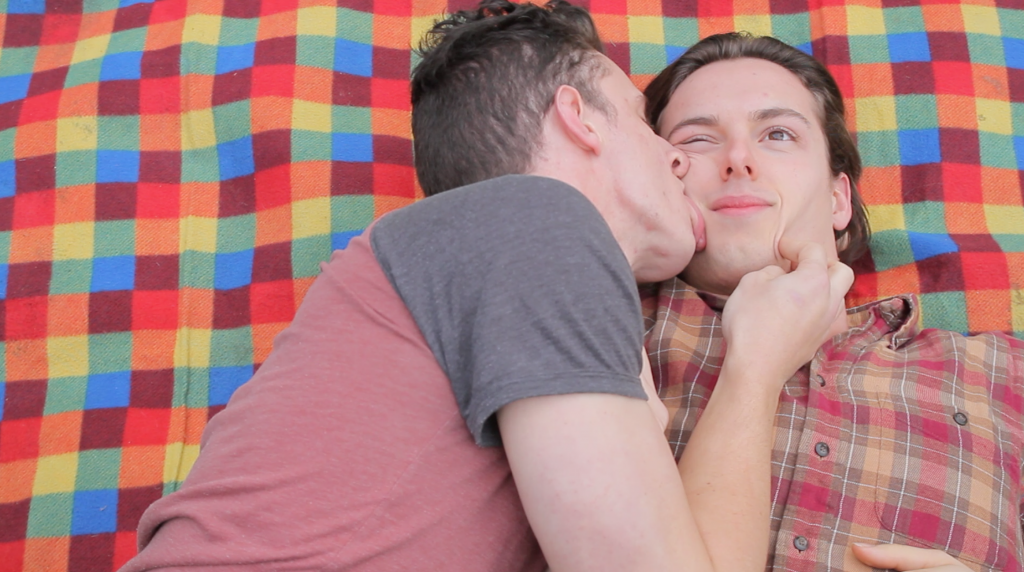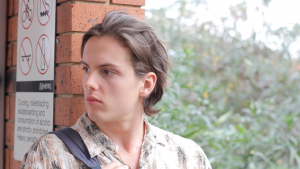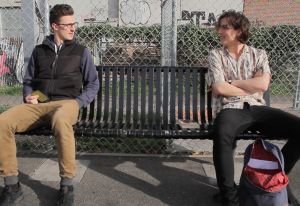So far I have edited 5 scenes for Touch On/Touch Off: scenes 1, 8, 9, 11 and 13 (joining 8 and 9 together and 11 and 13 together in the clips below). On average it was taking me about 1 hour to edit together 30 seconds of footage. Aside from initially looking over all of the clips for each scene, the time-consuming part was really editing the audio rather than the visuals. (I had already edited together the visuals for my test shoots of a few of these scenes, so I already knew what would work in terms of ordering). Although Premiere Pro is incredible at automatically syncing up bad sound from the audio recording on my DSLR with the good audio, it still takes a bit of time to do. In addition, adjusting levels became a problem once I realised how different the audio sounded through my good quality headphones in comparison to speakers in a room, or the bad quality speakers in my laptop. Thus, I had to keep testing the audio levels through different kinds of speakers to find a ‘happy medium’.
In saying that, as soon as the scenes were played in the cinema environment the audio levels sounded completely different again. This was the same for the visuals. To be honest, seeing the film on the big screen was a bit of a slap in the face, because everything seemed to look far worse when it was blown up to that size. The colour grading looked wrong – it was too white, too overexposed and far too saturated; even though it had looked seemingly natural on my computer screen when I was editing. There were also a few shots that I hadn’t realised were slightly out of focus, which degraded the overall quality of the scenes – all of these shots were (of course) shot with my wide angle lens; I’ve got to stop using it. Through this process I have realised that it is just as important to do test runs with the final footage (whether it be on different screens, or different speakers) as it is do test shoots, because you just don’t know how it will look or sound in an alternative environment. It has also left me pondering how I may be able to combat this problem from the start: from when I’m actually shooting. I have mentioned this before, but it is very difficult to get focus and exposure absolutely correct when you’re looking at a screen or through a viewfinder which is only a couple of inches big. No wonder I only picked up on a few mistakes when I watched the footage on a big screen: it’s literally 1000 times bigger than the screen on my camera! In the future I will definitely consider using a monitor to shoot with… all I have to do now is figure out if there is some way I can hook the monitor up to my DSLR without losing the display on my camera screen.
SCENE 1 EDIT
I had already edited this scene before, but I thought I ought to re-edit it after the feedback I got from Paul and the rest of the class. I decided to replace the tilt up shot with a wide angle shot, because the closeup of Will’s face was too out of focus (not that the wide shot is much better in the end). I may need to play with the audio levels a bit more as well because the sound of Will putting the phone back down on the table is too loud in comparison to everything else.
SCENE 1 FIRST EDIT
SCENE 1 RE-EDIT
SCENE 8 AND 9 EDIT
For the purpose of making narrative sense with using just these two scenes I actually put scene 9 (the cafe scene) in front of scene 8; however, the order will be reversed (back to normal) for the final edit. I am happy with how the three cutaways at the beginning of the scene establish the cafe environment. The crunching sound effect for the toast eating shot is a little bit out, so I will need to fix that up later, but otherwise the initial soundscape is pretty good; I particularly like how the dialogue about Metamorphosis comes in before we see who is talking (thus creating a J cut). I think I could have continued in this fashion by moving onto the next shot before the character finishes his lines to make the scene flow slightly better.
I can’t believe the big pan/dolly shot for this scene worked. Although we did many practices before Bridget (who plays the waitress Claudia) had to actually carry the tray of full coffees, it was still a scary shot to shoot, because we had to do it in one take. There’s one part of the shot where I wish I had’ve moved the camera a bit faster to keep up with Bridget as she walked, but overall, it’s pretty good for only getting one chance to shoot it. I made the decision to cut from this long take to the mid shot of Peta slightly early (i.e. before the camera finished panning), because otherwise it showed too much of the background of the set: there was a washing line next to the ‘cafe’ and I wanted to avoid displaying any remnants of the actual house we were shooting at.
I think this scene would dramatically improve if I added some diegetic background music to emphasise the chaotic vibe of the cafe; maybe something manic and jazzy. This would further highlight the tonal differences between the crazy cafe scenes and the relaxed and dreamy scenes of George wandering around Melbourne. To an extent, the ‘slower’ editing and acting/staging style of the park scene differentiates it from the cafe scene. We purposely didn’t include any camera movement in the park scene so it would feel more calm and ‘stable’, in comparison to the cafe scene/s. Nevertheless, I think some ethereal music for the park sequence would also strengthen the tonal contrast between the two scenes.
I think the edit for this scene is fine, but I really need to fix up the sound effects. At the moment some sounds are too loud and others are missing altogether. The problem is that we only got one wild audio track for this scene and not all of the sounds I need are there, so I may have to get some royalty free foley off the internet. My only other considerations for modifying this scene is possibly taking out the high angle shot of George falling onto his back (by cutting back to the wide shot) and maybe using a different shot of the tree canopy because the current one is quite shaky.
SCENE 11 AND 13 EDIT
Again, I have played with the order of these two scenes. There is meant to be another scene between them, but I liked how they fitted together, so I decided to edit them next to each other, even if it is just for the studio screening.
Depending on how this cafe/angry customer scene fits into the final edit, I may cut out the first shot of the sequence with Claudia scrubbing the concrete where she dropped the coffee. Even though it is a nice continuation from the cafe scene prior to this, I don’t like the shot because the background is very overexposed (because I was exposing for the foreground). We also don’t have enough audio to play over this shot to continue it on into the next shot of the customer complaining. (For some reason we only recorded the part of the complaint that was in the script and did not think to do some improvisation to start the angry customer off on her rant). I think it will work better if we cut straight from scene 12 to the mid-closeup of the angry customer mid-protest.
Scene 13 was simple to cut together visually, but the atmos, foley and soundtrack creates a complex soundscape. I think I could improve the transition into this scene for the final edit by getting rid of the fade from black and bringing the background noise in a bit earlier. I think the song works well to create a ‘Melbourne wine bar’ ambience and helps to establish a relaxed vibe, which reflects George’s state of mind at this point in the narrative. I may need to alter the EQ of the mosquito foley to make it sound more like it’s actually coming from within the wine bar environment and maybe also figure out a way of making it look like the mosquito was actually squished onto Will/George’s arm, but I’m not sure if people notice this or not.
All in all, I don’t mind the edits, but I think I still have a long way to go until I can safely say they are ready for a proper screening as part of the film.



